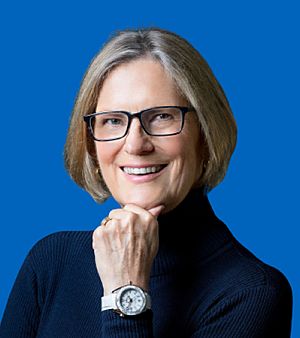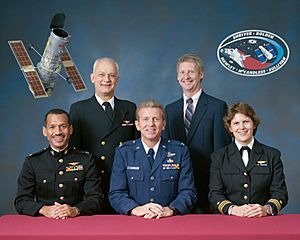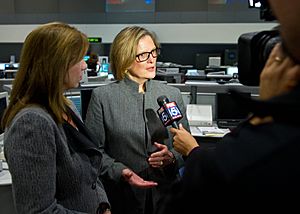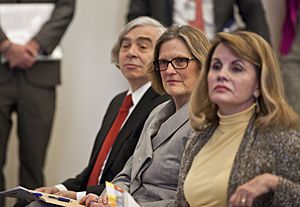Kathryn D. Sullivan facts for kids
Quick facts for kids
Kathryn Sullivan
|
|
|---|---|
 |
|
| Born |
Kathryn Dwyer Sullivan
October 3, 1951 Paterson, New Jersey, U.S.
|
| Awards |
|
| Space career | |
| NASA astronaut | |
| Rank | Captain, USN |
|
Time in space
|
22d 4h 49m |
| Selection | NASA Group 8 (1978) |
|
Total EVAs
|
1 |
|
Total EVA time
|
3h 29m |
| Missions | STS-41-G STS-31 STS-45 |
|
Mission insignia
|
|
|
|
| In office March 1, 2013 – January 20, 2017 Acting: March 1, 2013 – March 6, 2014 |
|
| President | Barack Obama |
| Preceded by | Jane Lubchenco |
| Succeeded by | Benjamin Friedman (acting) |
| Scientific career | |
| Fields |
|
| Institutions | |
| Thesis | The Structure and Evolution of the Newfoundland Basin, Offshore Eastern Canada (1978) |
| Doctoral advisor | Michael John Keen |
Kathryn Dwyer Sullivan (born October 3, 1951) is an American geologist and oceanographer. She is also a former NASA astronaut and US Navy officer. She flew on three Space Shuttle missions.
Kathryn Sullivan graduated from the University of California, Santa Cruz. She also earned a PhD in geology from Dalhousie University in Canada in 1978. She was one of the first six women chosen to be an astronaut by NASA. This was part of NASA Astronaut Group 8.
During her training, she became the first woman to wear a United States Air Force pressure suit. On July 1, 1979, she set a record for the highest altitude flown by an American woman. On her first mission, STS-41-G, she was the first American woman to perform a spacewalk. On her second mission, STS-31, she helped launch the Hubble Space Telescope. Her third mission, STS-45, was the first Spacelab flight focused on studying Earth.
After her time as an astronaut, Sullivan became a leader in ocean and atmosphere science. She was the Administrator of the National Oceanic and Atmospheric Administration (NOAA). This role ended on January 20, 2017. On June 7, 2020, she became the first woman to dive into the Challenger Deep. This is the deepest part of Earth's oceans. In September 2021, President Joe Biden appointed her to a science advisory council.
Contents
Early Life and Education
Kathryn Dwyer Sullivan was born in Paterson, New Jersey, on October 3, 1951. Her parents were Donald Paul and Barbara Sullivan. In 1958, her family moved to California. Her father worked in the aerospace industry there. She went to Havenhurst Elementary School, where Sally Ride was also a student. However, they did not remember meeting each other. Kathryn was a girl scout during her school years.
She graduated from William Howard Taft High School in Los Angeles in 1969. She planned to work in foreign service. She chose the University of California, Santa Cruz (UCSC) for its Russian studies program. UCSC required science classes for humanities students. She took courses in marine biology and oceanography. She enjoyed these subjects and changed her focus to science.
She studied abroad at the University of Bergen in Norway from 1971 to 1972. This experience made her decide to major in oceanography. She earned a Bachelor of Science degree in Earth Sciences from UCSC in 1973. In 1978, she received her PhD in geology from Dalhousie University in Canada. Her PhD research was about the structure of the Newfoundland Basin. While at Dalhousie, she joined several trips to study the Atlantic and Pacific ocean floors.
Becoming a NASA Astronaut
Joining the Astronaut Team
In 1976, Kathryn's brother, Grant, told her that NASA was looking for new astronauts. NASA wanted to include women for the first time. Grant encouraged her to apply. She saw a NASA ad in a science journal and decided to apply. She thought the Space Shuttle was like a research vessel. Her dream was to explore the ocean floor in a submersible.
She was invited to the Johnson Space Center (JSC) for interviews and physical tests. This happened in November 1977. She was the only woman in this group of 25 finalists. She passed the tests and interviews. On January 16, 1978, NASA announced her selection. She was one of six women among 35 new astronauts. This was the first group of astronauts to include women.
On August 31, 1979, NASA announced that the new astronauts had finished their training. They were now officially qualified for space flights. Kathryn Sullivan helped create checklists for the first Space Shuttle flights. She also worked as a mission manager for NASA's High Altitude Research Project. On July 1, 1979, she flew in a WB-57F aircraft. She reached an unofficial altitude record for women of 19,200 meters (63,000 feet).
For the first Space Shuttle mission, STS-1, Sullivan helped with media support. She also flew in a chase plane for the STS-2 mission. She took photos of the Space Shuttle's tiles to check for damage. She then joined the support crew at the Kennedy Space Center (KSC) for four more Space Shuttle missions.
First Spacewalk: STS-41-G
In July 1983, Sullivan joined a group that developed payloads for future missions. She worked on the OSTA-3 satellite and the Orbital Refueling System (ORS). The ORS aimed to show that the Space Shuttle could refuel a satellite in orbit. This would extend its useful life. The Landsat 4 satellite was chosen for this demonstration. In September 1983, she was assigned to this mission, called STS-41-G.
Sally Ride was also on this mission. It was the first time two women were in space together. The mission launched from KSC on the Space Shuttle Challenger on October 5, 1984. On October 11, 1984, Sullivan made history. She performed the first extra-vehicular activity (EVA), or spacewalk, by an American woman. With fellow astronaut David Leestma, she spent 3.5 hours outside the Shuttle. They used the ORS to show that a satellite could be refueled in orbit. They transferred 59 kilograms (130 pounds) of hydrazine to a mock satellite system. This proved the procedure could work.
During the eight-day mission, the crew also launched the Earth Radiation Budget Satellite. They conducted scientific observations of Earth using various instruments. The mission completed 132 orbits of Earth in 197.5 hours. It landed back at KSC on October 13, 1984.
Deploying Hubble: STS-31
In September 1985, Sullivan was assigned to the STS-61-J mission. This mission was planned to deploy the Hubble Space Telescope (HST). The original plan was to bring HST back to Earth for maintenance. But NASA decided it would be too dangerous and costly. Instead, HST would be maintained in orbit. Sullivan worked to make sure as many parts as possible could be replaced or fixed in space.
The STS-61-J mission was canceled after the 1986 Space Shuttle Challenger disaster. However, the crew continued to work on the HST mission goals. Sullivan also served as a capsule communicator (CAPCOM) for later Space Shuttle missions. She was CAPCOM for STS-26, STS-27, and STS-29.
In March 1989, Sullivan returned to working on the HST mission, now called STS-31. The mission launched from KSC on April 24, 1990. During this five-day mission, the crew on the Space Shuttle Discovery deployed the HST. They also did experiments on protein growth and weightlessness. They used cameras to observe Earth. Their highest point above Earth was 617 kilometers (333 nautical miles). This was the highest a Space Shuttle had ever flown at that time.
The HST was deployed on the second day using Discovery's Canadarm. The Shuttle's cabin pressure was lowered in case a spacewalk was needed. At one point, Sullivan and another astronaut put on their space suits. They were ready to perform an emergency spacewalk to help deploy Hubble's solar arrays. But this was not needed, as engineers on Earth were able to deploy them. Discovery landed at Edwards Air Force Base in California on April 29, 1990.
Studying Earth: STS-45
Sullivan was the Payload Commander for STS-45. This was the first Spacelab mission focused on NASA's Mission to Planet Earth. It launched on the Space Shuttle Atlantis on March 24, 1992. During this nine-day mission, the crew operated twelve experiments. These experiments studied the Earth's atmosphere and its changes over time. The mission also measured the ozone layer.
Atlantis landed at the Kennedy Space Center on April 2, 1992. Sullivan left NASA in 1993. She had flown on three Space Shuttle missions and spent 532 hours in space.
Military Career

In 1985, Sullivan became a geology professor at Rice University. In 1988, she joined an oceanographic research trip. There, she met a US Navy oceanographer. She started thinking about joining the US Naval Reserve (USNR). Later that year, she became an officer in the USNR. She held the rank of lieutenant commander.
In October 1990, she took command of a small unit of oceanographers and meteorologists. This unit supported the Naval Meteorology and Oceanography Command center on Guam. The unit went to Guam in January 1991, just before Operation Desert Storm began. She retired from the USNR as a captain in 2006.
Civilian Career
NOAA Chief Scientist
While preparing for STS-45, Sullivan was asked to become the chief scientist of the National Oceanic and Atmospheric Administration (NOAA). She was confirmed for this role on May 28, 1993. As chief scientist at NOAA, she managed research into climate change, oceanography using satellites, and marine biodiversity.
Leadership Roles (1996-2011)
From 1996 to 2006, Sullivan was president and CEO of the COSI Columbus. This is an interactive science center in Columbus, Ohio. From 2006 to 2011, she directed a center for math and science education policy at Ohio State University. She was also appointed vice chair of the National Science Board in 2004.
Assistant Secretary of Commerce
In January 2011, President Barack Obama nominated Sullivan to be an Assistant Secretary of Commerce. She was confirmed by the Senate on May 4, 2011. She became Acting Under Secretary of Commerce for Oceans and Atmosphere and Acting NOAA Administrator on February 28, 2013. President Obama nominated her for the full role on August 1, 2013. She was confirmed by the Senate on March 6, 2014. Her term ended on January 20, 2017.
Recent Positions (Since 2017)
In 2017, Sullivan was named the Charles A. Lindbergh Chair of Aerospace History. This is a fellowship at the National Air and Space Museum. Her research there focused on the Hubble Space Telescope. She also served as a Senior Fellow at the Potomac Institute for Policy Studies. Her book, Handprints on Hubble: An Astronaut's Story of Invention, was released in November 2019. It tells her story of helping to launch and maintain the Hubble Space Telescope.
In June 2020, Sullivan traveled to the bottom of the Challenger Deep. This is in the Mariana Trench, the deepest part of Earth's oceans. She became the first woman and eighth person to reach this point. She is also the first person to travel both to Challenger Deep and into space. In November 2020, she was named a volunteer member of Joe Biden's presidential transition team. In September 2021, President Biden appointed her to the President's Council of Advisors on Science and Technology.
Awards and Recognition
Sullivan received many awards from NASA. These include the NASA Space Flight Medal (1984, 1990, 1992) and the NASA Exceptional Service Medal (1988, 1991). She also received the NASA Outstanding Leadership Medal in 1992. Other awards include the Gold Medal of the Society of Woman Geographers in 1993. She received the Golden Plate Award of the American Academy of Achievement in 1994. In 2004, she received the Adler Planetarium Women in Space Science Award.
In 2014, Sullivan was named to the Time 100 list. This list features the world's most influential people. John Glenn, a famous astronaut, wrote about her. He said she was not just a scientist. He highlighted her role as one of NASA's first female astronauts. He mentioned her spacewalk and her work with the Hubble Space Telescope. Glenn believed she was the right person to help with climate change issues.
Sullivan received honorary Doctor of Science degrees from Willamette University in 2013 and Brown University in 2015. In September 2015, she gave a lecture at the Smithsonian National Air and Space Museum. She talked about her life of exploration and how NOAA helps us understand Earth's environmental challenges.
Sullivan was inducted into the Astronaut Hall of Fame in 2004. She was elected to the National Academy of Engineering in 2016. In 2017, she joined the American Academy of Arts and Sciences. In 2020, she was named an Honorary Geographer by the American Association of Geographers. She was also on the BBC's 100 Women list in November 2020. In September 2023, Sullivan was inducted into the National Aviation Hall of Fame in Dayton, Ohio.
See also
 In Spanish: Kathryn D. Sullivan para niños
In Spanish: Kathryn D. Sullivan para niños
- List of female astronauts
- List of people who descended to Challenger Deep






